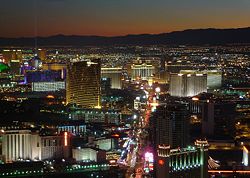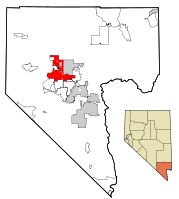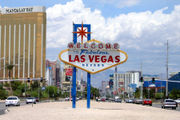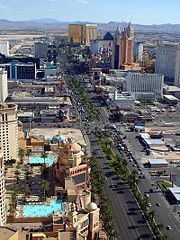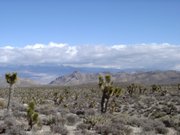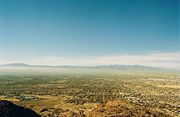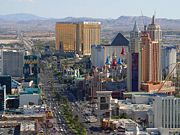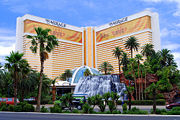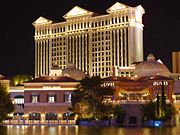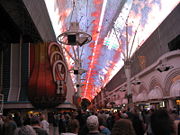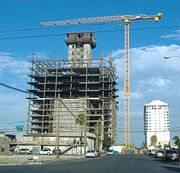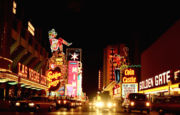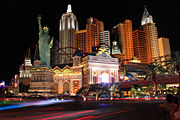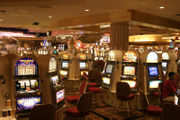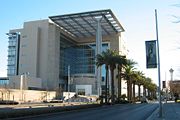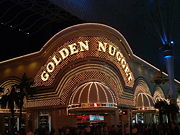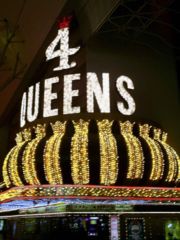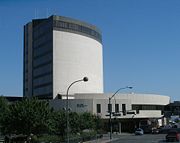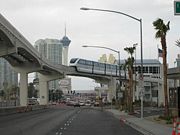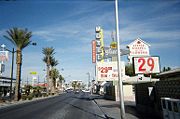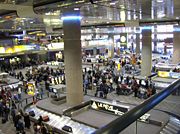Las Vegas, Nevada
2008/9 Schools Wikipedia Selection. Related subjects: Cities; North America
| City of Las Vegas | |||
| Las Vegas | |||
|
|||
| Nickname(s): "The Entertainment Capital of the World", "Sin City" |
|||
| Location of Las Vegas in Clark County, Nevada | |||
| Coordinates: | |||
|---|---|---|---|
| Country | United States | ||
| State | Nevada | ||
| County | Clark County | ||
| Government | |||
| - Type | Council-Manager | ||
| - Mayor | Oscar B. Goodman ( D) | ||
| - City Manager | Douglas Selby | ||
| Area | |||
| - City | 131.3 sq mi (340.0 km²) | ||
| - Land | 131.2 sq mi (339.8 km²) | ||
| - Water | 0.1 sq mi (0.16 km²) | ||
| Elevation | 2,001 ft (610 m) | ||
| Population (2006) | |||
| - City | 552,539 | ||
| - Density | 4,154/sq mi (1,604/km²) | ||
| - Metro | 1,777,539 | ||
| Time zone | PST ( UTC−8) | ||
| - Summer ( DST) | PDT ( UTC−7) | ||
| ZIP codes | |||
| Area code(s) | 702 | ||
| FIPS code | 32-40000 | ||
| GNIS feature ID | 0847388 | ||
| Website: City of Las Vegas Nevada | |||
Las Vegas (Spanish: "The meadows") is the most populous city in the state of Nevada, the seat of Clark County, and an internationally renowned major resort city for the gaming industry, shopping, and entertainment. Las Vegas, billed as The Entertainment Capital of the World, is famous for the number of large casino resorts and their associated entertainment. The city's tolerance for various forms of adult entertainment earned it the title of Sin City, and this image has made Las Vegas a popular setting for films and television programs. Outdoor lighting displays are everywhere on the Las Vegas Strip and are seen elsewhere in the city as well; as seen from space, Las Vegas is the brightest city on earth.
Established in 1905, Las Vegas officially became a city in 1911. With the growth that followed, at the close of the century Las Vegas was the most populous American city founded in the 20th century (a distinction held by Chicago in the 19th century). As the 28th most populous city in the United States, the Las Vegas metropolitan area contains approximately 1.8 million residents, and is one of most populous cities in the American West.
The name Las Vegas is often applied to the unincorporated areas of Clark County that surround the city, especially the resort areas on and near the Las Vegas Strip. This 4.5- mile (7.2- km) stretch of Las Vegas Boulevard is mostly outside the city limits, in the unincorporated towns of Paradise and Winchester.
History
Founding
Las Vegas was named by Spaniards in the Antonio Armijo party, who used the water in the area while heading north and west along the Old Spanish Trail from Texas. In the 1800s, areas of the Las Vegas Valley contained artesian wells that supported extensive green areas or meadows (vegas in Spanish), hence the name Las Vegas.
John C. Frémont traveled into the Las Vegas Valley on May 3, 1844, while it was still part of Mexico. He was a leader of a group of scientists, scouts and observers for the United States Army Corps of Engineers. On May 10, 1855, following annexation by the United States, Brigham Young assigned 30 missionaries of The Church of Jesus Christ of Latter-day Saints led by William Bringhurst to the area to convert the Paiute Indian population to Mormonism. A fort was built near the current downtown area, serving as a stopover for travelers along the " Mormon Corridor" between Salt Lake and the briefly thriving colony of "saints" at San Bernardino, California. However, Mormons abandoned Las Vegas in 1857. Las Vegas was established as a railroad town on May 15, 1905, when 110 acres (44.5 ha) owned by Montana Senator William A. Clark's San Pedro, Los Angeles and Salt Lake Railroad, was auctioned off in what is now downtown Las Vegas. Las Vegas was part of Lincoln County until 1909 when it became part of the newly established Clark County. The St. Joan of Arc Catholic Church near 4th and Bridger in downtown was founded in 1910.Las Vegas became an incorporated city on March 16, 1911.
Gambling was legalized on March 19, 1931 in the city and the opening of Bugsy Siegel's Flamingo Hotel on what would become the Las Vegas Strip on December 26, 1946. Various events have had an impact on the city. The Hoover Dam was completed on October 9, 1936 and atmospheric nuclear testing was conducted at the Nevada Test Site (1951 to 1962). On November 21, 1980 a Hotel fire at the MGM Grand, devastated the city and State of Nevada. On November 22, 1989 the opening of The Mirage began the era of megaresort casinos.
Economic history
Las Vegas started as a stopover on the pioneer trails to the west, and became a popular railroad town in the early 1900s. It was a staging point for all the mines in the surrounding area, especially those around the town of Bullfrog, that shipped their goods out to the rest of the country. With the proliferation of the railroads, Las Vegas became less important, but the completion of the nearby Hoover Dam resulted in a substantial growth in tourism, which, along with the legalization of gambling, led to the advent of the casino-hotels for which Las Vegas is famous.
The city owes almost all its current status and reputation to the American mafia. All of the original large casinos were managed or at least funded under mob figures Benjamin "Bugsy" Siegel and Meyer Lansky.
The constant stream of tourist dollars from the hotels and casinos was augmented by a new source of federal money. This money came from the establishment of what is now Nellis Air Force Base. The influx of military personnel and casino job-hunters helped start a land building boom which still goes on today.
Although the city's gambling economy continues to expand, in 2006 gambling revenues in the Macau Special Administrative Region in the People's Republic of China surpassed those in Las Vegas, making Macau the largest gambling centre in the world. With revenues in excess of $10 billion for 2007, Macau is poised to surpass the entire state of Nevada in gambling revenues. Due to the gambling boon in Macau, many traditional Las Vegas casino developers, such as Steve Wynn, are pursuing multi-billion dollar projects in its expanding market. There is no evidence as of yet to suggest that gambling growth in Macau is shifting growth away from Las Vegas.
Geography
Topography
Las Vegas is located at (36.194168, 115.222060). According to the United States Census Bureau, the city has a total area of 131.3 square miles (340.0 km2), of which, 131.2 square miles (339.8 km2) of it is land and 0.1 square miles (0.26 km2) of it (0.04%) is water.
The city is located in an arid basin surrounded by mountains varying in colour from pink to rust to gray. City elevation is around 2030 feet (620 m) above sea level. The Spring Mountains lie to the west. As befits a desert, much of the landscape is rocky and dusty. Within the city, however, there are a great deal of lawns, trees, and other greenery. Due to water resource issues, there is now a movement to encourage xeriscapes instead of lawns. Another part of the water conservation efforts include scheduled watering groups for watering residential landscaping.
Climate
Las Vegas' climate is an arid desert climate ( Koppen climate classification BWh) typical of the Mojave Desert, in which it is located, marked with very hot summers, mild winters, abundant sunshine year-round, and very little rainfall. Temperatures in the 90s °F (mid-30s °C) are common in the months of May, June, and September and temperatures normally exceed 100 °F (38 °C) most days in the months of July and August, but with very low humidity, frequently under 10%. The hottest temperature ever recorded is 117 °F (47 °C) set twice, on July 19, 2005, at McCarran International Airport and July 24, 1942, at present-day Nellis Air Force Base. Winters are mild and usually are cool and windy, with the majority of Las Vegas' annual 4.49 in (114 mm) of rainfall coming from January to March. Winter daytime highs are normally around 60 °F (16 °C) and winter nighttime lows are usually around 40 °F (4 °C). The coldest temperature ever recorded is 8 °F (−13 °C) set on January 25, 1937, at present-day Nellis Air Force Base. Showers occur less frequently in the Spring or Autumn. July through September, the Mexican monsoon often brings enough moisture from the Gulf of California across Mexico and into the southwest to cause afternoon and evening thunderstorms. Although winter snow is usually visible from December to May on the mountains surrounding Las Vegas, it rarely snows in the city itself. Although temperature and precipitation records for Las Vegas date back to the early part of the 20th Century, official temperature and precipitation records for Las Vegas date back as early as 1937.
| Monthly Normal and Record High and Low Temperatures | |||||||||||||
| Month | Jan | Feb | Mar | Apr | May | Jun | Jul | Aug | Sep | Oct | Nov | Dec | Year |
|---|---|---|---|---|---|---|---|---|---|---|---|---|---|
| Rec Daytime High °F/ °C | 77/ 25 | 87/ 31 | 92/ 33 | 99/ 37 | 109/ 42.8 | 115/ 46 | 117/ 47 | 116/ 46.6 | 113/ 45 | 103/ 39.4 | 87/ 31 | 77/ 25 | 117/ 47 |
| Average High °F/°C | 57.1/ 13.9 | 63/ 17.2 | 69.5/ 20.7 | 78.1/ 25.6 | 87.8/ 31.0 | 98.9/ 37.2 | 104.1/ 40.1 | 101.8/ 38.8 | 93.8/ 34.3 | 80.8/ 27.1 | 66/ 18.9 | 57.3/ 14.1 | 79.9/ 26.8 |
| Rec Nighttime High °F/°C | 58/ 14 | 59/ 15 | 71/ 21 | 74/ 23 | 89/ 32 | 89/ 32 | 95/ 35 | 90/ 33 | 84/ 29 | 79/ 27 | 62/ 16 | 57/ 14 | 95/ 35 |
| Average Low °F/°C | 36.8/ 2.8 | 41.4/ 5.2 | 47/ 8.3 | 53.9/ 12.2 | 62.9/ 17.2 | 72.3/ 22.4 | 78.2/ 25.7 | 76.7/ 24.8 | 68.8/ 20.4 | 56.5/ 13.6 | 44/ 6.7 | 36.6/ 2.6 | 56.3/ 13.5 |
| Rec Nighttime Low °F/°C | 8/ −13 | 16/ −9 | 23/ −5 | 31/ −1 | 40/ 5 | 48/ 9 | 60/ 16 | 56/ 13 | 46/ 8 | 26/ −3 | 21/ −6 | 11/ −12 | 8/ −13 |
| Rec Daytime Low °F/°C | 28/ −2 | 34/ 1 | 42/ 6 | 48/ 9 | 60/ 16 | 67/ 19 | 81/ 27 | 74/ 23 | 67/ 19 | 50/ 10 | 42/ 6 | 32/ 0 | 28/ −2 |
| Precip (in/cm) | 0.59/ 1.50 | 0.69/ 1.75 | 0.59/ 1.50 | 0.15/ 0.38 | 0.24/ 0.61 | 0.08/ 0.20 | 0.44/ 1.12 | 0.45/ 1.14 | 0.31/ 0.79 | 0.24/ 0.61 | 0.31/ 0.79 | 0.4/ 1.02 | 4.49/ 11.40 |
| Average snow (in/cm) | 0.9/ 2.3 | 0.1/ 0.3 | <0.1/ <0.1 | none | none | none | none | none | none | none | none | none | <0.1/ <0.1 |
| Record snow (in/cm) | 16.7/ 42.4 | 4.1/ 10.4 | 0.1/ .3 | none | none | none | none | none | none | trace | 4.0/ 10.2 | 2.0/ 5.1 | 16.7/ 42.4 |
| Source: National Weather Service | |||||||||||||
Environment
Las Vegas is situated on the arid floor within Clark County. Correspondingly, the surrounding environment is dominated by desert vegetation and some wildlife, and the area can be subject to torrential flash floods. Enabling the rapid population expansion was a major addition to the city's sewage treatment capacity. The sewage treatment expansion resulted from a U.S. Environmental Protection Agency grant funded 208 programs to analyze and forecast growth and environmental impacts through the year 2019.
Cityscape
Redevelopment
When The Mirage, the first Megaresort, opened in 1989, it started a movement of people and construction away from downtown Las Vegas to the Las Vegas Strip. This resulted in a drop in tourism from the downtown area but many recent projects and condo construction have seen an increase in visitors to downtown.
A concerted effort has been made by city officials to diversify the economy from tourism by attracting light manufacturing, banking, and other commercial interests. The lack of any state individual or corporate income tax and very simple incorporation requirements have fostered the success of this effort.
Having been late to develop an urban core of any substantial size, Las Vegas has retained very affordable real estate prices in comparison to other western U.S. cities. Consequently, the city has recently enjoyed an enormous boom both in population and in tourism. However, as a New York Times series on the city reported in 2004, the median price of housing in the Las Vegas Valley is now at or above the nationwide median. The urban area has grown outward so quickly that it is beginning to run into Bureau of Land Management holdings along its edges, increasing land values enough that medium- and high-density development is beginning to occur closer to the core.
As a reflection of the city's rapid growing population, the new Chinatown of Las Vegas was constructed in the early 1990s on Spring Mountain Road. Chinatown initially consisted of only one large shopping centre complex, but the area was recently expanded for new shopping centers that contain various Asian businesses.
With the Strip expansion in the 1990s, the downtown area (which has maintained an old Las Vegas feel) began to suffer. The city made a concise effort to turn around the fortunes of downtown. The Fremont Street Experience (FSE) was built in an effort to draw tourists back to the area and has proven to be popular in that regard. The multi-level Neonopolis, complete with 11 theaters (managed by Galaxy Theaters, Inc.), was built to offer more retail opportunity and services. Many highrise condo projects have also been underway as downtown is transforming into a livable neighbourhood. Other promising signs emerged for the area. The city had successfully lured the Internal Revenue Service operations from the far west of the city to a new downtown building that opened in April 2005. The IRS move is expected to create a greater demand for additional businesses in the area, especially in the daytime hours.
The city purchased 61 acres (247,000 m2) of property from Union Pacific Railroad in 1995 with the goal of creating something that would draw more tourists and locals to the downtown area. In 2004 Las Vegas Mayor Oscar Goodman announced plans for the Union Park Development which will include residential and office high-rises, The Lou Ruvo Brain Institute, an academic medical centre, The Smith Centre for the Performing Arts, and a new City Hall. After failed negotiations with The Related Co. on the development of Union Park in October of 2005, San Diego-based Newland Communities was chosen by the city as the new development firm. The Newland contract calls for Dan Van Epp, Newland's regional vice president and former president of the Howard Hughes Corp., to oversee his company's work on Union Park. The Lou Ruvo Brain Institute is expected to be completed in 2007.
Along with the Union Park Development, other promising residential and office developments have begun construction around downtown Las Vegas. New condominium and hotel high rise projects have changed the entire Las Vegas skyline dramatically in recent years. Many large high-rise projects are planned for downtown Las Vegas as well as the Las Vegas Strip.
The city council of Las Vegas has also agreed on zoning changes on Fremont Street, which allows bars to be closer together, such as the Gaslamp Quarter of San Diego. It is expected that this change will bring more tourism and business to the downtown area.
In 2004, the city partnered with Cheetah Wireless Technologies and MeshNetwork to pilot a wide area mobile broadband system. The pilot system is installed downtown, around the Fremont Street Experience.
In 2005, on a lot adjacent to the city's 61 ac (247,000 m2), the World Market Centre opened. It is intended to be the nation's and possibly the world's preeminent furniture wholesale showroom and marketplace, and is meant to compete with the current furniture market capital of High Point, North Carolina.
On October 23, 2006, plans were unveiled to build a World Jewelry Center in Downtown's Union Park. Similar to the World Market Centre, the WJC will be a one stop shop for jewelry trade shows from around the world. The project proposes a 57-story, 815-foot (248 m) office tower.
Economy
The primary drivers of the Las Vegas economy have been the confluence of tourism, gaming, and conventions which in turn feed the retail and dining industries. Several companies involved in the manufacture of electronic gaming machines, such as slot machines, are located in the Las Vegas area. In the 2000s retail and dining have become attractions of their own.
Tourism marketing and promotion are handled by the Las Vegas Convention and Visitors Authority, a county wide agency. Its annual Visitors Survey provides detailed information on visitor numbers, spending patterns and resulting revenues .
Las Vegas, as the county seat and home to the Lloyd D. George Federal District Courthouse, draws numerous legal service industries providing bail, marriage, divorce, tax, incorporation and other legal services.
Some technology companies have either relocated to Las Vegas or were created there. For various reasons, the Las Vegas area has had a high concentration of technology companies in electronic gaming and telecommunications industries. Some current technology companies in southern Nevada include Bigelow Aerospace, CommPartners, Datanamics, eVital Communications, Petroglyph, SkywireMedia, Switch Communications, and WorldDoc. Companies that originally were formed in Las Vegas, but have since sold or relocated include Westwood Studios (sold to Electronic Arts), Systems Research & Development (Sold to IBM), Yellowpages.com (Sold to Bellsouth and SBC), and MPower Communications.
Constant population growth means that the housing construction industry is vitally important. In 2000 more than 21,000 new homes and 26,000 resale homes were purchased. In early 2005 there were 20 residential development projects of more than 300 acres (1.2 km²) each underway.
Culture
Tourism
The major attractions in Las Vegas are the casinos. The most famous hotels are located on Las Vegas Boulevard, better known as the Las Vegas Strip. Many of these hotels carry thousands of rooms. There are, of course, large casino areas in these hotels as well. There are many hotel casinos in the city's downtown area as well, which was the original focal point of the city's gaming industry in its early days. Several large hotels and casinos are also located somewhat off the Strip but adjacent to it, as well as in the county around the city.
Some of the most notable casinos located downtown are on the Fremont Street Experience and include:
- Golden Nugget
- Four Queens
- Binion's Gambling Hall and Hotel
- Fremont Casino
- Plaza Hotel & Casino
- Las Vegas Club
- Fitzgeralds Las Vegas
- Golden Gate Hotel and Casino
- California Hotel and Casino
Parks
- City of Las Vegas Parks listing
- Las Vegas Springs Preserve Recreational and educational facility
- Floyd Lamb State Park
Music
A number of popular music acts have originated from Las Vegas including rock bands The Killers, Panic at the Disco, The Higher, The Cab, Escape The Fate, Slaughter, rhythm and blues group 702 (band), hip-hop recording artist Lil Jay and singer Jenny Lewis. While the electronic music duo The Crystal Method was founded in Los Angeles, both members, Ken Jordan and Scott Kirkland, are from Las Vegas.
Local Arts
On the first Friday of each month, the "First Friday" celebration is held which exhibits the works of local artists and musicians in a section of the city's Downtown region now called the "Arts District".
Sports
Las Vegas does not have major-league sports, although the metropolitan population is as large or larger than many cities with professional sports teams. Part of the reason is that professional leagues are concerned about legal sports betting and the competition in entertainment. The city currently has two minor league sports teams, in baseball and hockey: The Las Vegas 51s of the Pacific Coast League (the AAA farm club of the Los Angeles Dodgers), and the Las Vegas Wranglers of the ECHL, respectively.
In the past, the city had teams in the Canadian Football League, the XFL and the Arena Football League. There was recent mention in the local media that the San Diego Chargers of the NFL may be considering Las Vegas as a relocation destination. There is speculation that the completion of a new arena (currently under construction) will bring teams from the NBA and NHL. The city is reportedly on the short list of Major League Soccer for an expansion franchise in the near future. There have also been contacts between city officials and several Major League Baseball owners regarding relocation. The ownership of the Florida Marlins held a widely-publicized meeting with Mayor Oscar Goodman in the winter of 2006. The city was a strong candidate to be the new home of the Montreal Expos, who eventually became the Washington Nationals. It was reported that the guarantee of a new stadium built entirely with public funds swung the balance in Washington's favour. Major League Baseball will hold their 2008 winter meetings in Las Vegas.
High profile one-time and limited-duration sporting events have been successful. Las Vegas hosted the NBA 2007 All-Star Game. The NASCAR Sprint Cup series has drawn up to 165,000 fans. Las Vegas also hosts a significant number of professional fights. Many of these fights (such as those in MMA's UFC) take place near downtown or on the Strip in one of the major resort/hotel/casino event centers. Mandalay Bay is frequently a top contender as a venue for the UFC. The National Finals Rodeo has drawn thousands of fans to the city since 1985, and a contract extension was signed in 2005 keeping the event in Las Vegas through 2014. The NBA Summer League is currently held in the city, and the USA Olympic basketball team trained in the city in 2008.
The University of Nevada, Las Vegas competes in NCAA Division I in men's and women's sports. UNLV is a member of the Mountain West Conference. The College of Southern Nevada also has an athletic program, with significant success in baseball at the community college level.
Demographics
| Historical populations | |||
|---|---|---|---|
| Census | Pop. | %± | |
| 1920 | 2,304 |
|
|
| 1930 | 5,165 | 124.2% | |
| 1940 | 8,422 | 63.1% | |
| 1950 | 24,624 | 192.4% | |
| 1960 | 64,405 | 161.6% | |
| 1970 | 125,787 | 95.3% | |
| 1980 | 164,674 | 30.9% | |
| 1990 | 258,295 | 56.9% | |
| 2000 | 478,434 | 85.2% | |
| Est. 2006 | 552,539 | 15.5% | |
| Source: City of Las Vegas | |||
Las Vegas has been the county seat of Clark County since the formation of the county in 1909. The Census Bureau's official population estimate, as of 2006, was 552,539, though the city’s own Planning and Development Department reported a population of 591,536 as of July, 2006.
The United States Census Bureau 2006 estimates place the population for the Las Vegas Metropolitan Statistical Area at 1,777,539 people, and the region is one of the fastest growing in the United States. Las Vegas proper was ranked as the 32nd most populous city in the United States in 2000, and 2006 estimates have placed the city 28th in rank.
As of the census of 2000, there were 478,434 people, 176,750 households, and 117,538 families residing in the city. The population density was 4,222.5 people per square mile (1,630.3/km2). There are 190,724 housing units at an average density of 1,683.3/sq mi (649.9/km2). The racial makeup of the city was 69.86% White, 10.36% African American, 0.75% Native American, 4.78% Asian, 0.45% Pacific Islander, 9.75% from other races, and 4.05% from two or more races. Hispanics are 23.61% of the population. Non-Hispanics whites are 58.04%. The top 5 largest ancestries include: German (12.2%), Irish (9.8%), English (8.4%), Italian (6.7%), and American (4.5%).
There were 176,750 households out of which 31.9% had children under the age of 18 living with them, 48.3% were married couples living together, 12.2% had a female householder with no husband present, and 33.5% were non-families. 25.0% of all households were made up of individuals and 7.5% had someone living alone who was 65 years of age or older. The average household size was 2.66 and the average family size was 3.20.
In the city the population was spread out with 25.9% under the age of 18, 8.8% from 18 to 24, 32.0% from 25 to 44, 21.7% from 45 to 64, and 11.6% who were 65 years of age or older. The median age was 34 years. For every 100 females there were 103.3 males. For every 100 females age 18 and over, there were 102.5 males.
The median income for a household in the city was $53,000 and the median income for a family was $58,465. Males had a median income of $35,511 versus $27,554 for females. The per capita income for the city was $22,060. About 6.6% of families and 8.9% of the population were below the poverty line, including 5.4% of those under age 18 and 6.3% of those age 65 or over.
In recent years, Las Vegas has been a popular destination for Hawaiians. In 2002, almost 80,000 former residents of Hawaii lived in Las Vegas, and nearly 3,000 Hawaiians visited Las Vegas every week. Las Vegas is sometimes referred to as Hawaii's Ninth Island. The city is the home to the first ABC Stores branch outside the state of Hawaii.
In December, 2007, Clark County officially declared the population now exceeds 2 million residents. Current estimates place growth at 3 million people by 2019, and 4 million people by 2025.
Las Vegas has one of the highest suicide and divorce rates of the U.S. The city's high divorce rate is partly due to the fact that divorce is easier in Nevada than most other states. The city was also ranked by Forbes as having the highest Income disparity in the nation.
Government
The City of Las Vegas government operates as a council-manager government. The Mayor sits as a Council member-at-large and presides over all of the City Council meetings. In the event that the Mayor cannot preside over a City Council meeting, the Mayor Pro-Tem is the presiding officer of the meeting until such time as the Mayor returns to his seat. The City Manager is responsible for the administration and the day-to-day operation of all of the municipal services and city departments. The City Manager also maintains intergovernmental relationships with federal, state, county and other local governments.
A large number of the people who live in what they call "Las Vegas" actually reside in neighboring incorporated cities or unincorporated communities. In fact, of the approximately 1.8 million people who live in the Las Vegas Valley, approximately 600,000 actually live inside Las Vegas city limits. Approximately 700,000 people live in unincorporated areas governed by Clark County, and another 465,000 live in incorporated cities such as North Las Vegas, Henderson and Boulder City. Las Vegas and most of the surrounding metropolitan area share a police department. The Las Vegas Metropolitan Police Department provides most law enforcement services in the city and surrounding county after a 1975 merger of the Las Vegas Police Department and the Clark County Sheriff's Department. Incorporated cities in Clark County, as well as colleges, parks and schools have their own police departments that fall outside of Metro's jurisdiction. The Las Vegas Marshals Department and the Las Vegas Municipal Marshals Department also provide law enforcement services.
A Paiute Indian reservation occupies about one acre (4000 m2) in the downtown area of Las Vegas.
City council
( Council members' official city websites are also available)
- Oscar B. Goodman – Mayor and Council member at Large (Term Expires in 2011)
- Gary Reese – Mayor Pro-Tem and 3rd Ward Council member (Term Expires in 2011)
- Lois Tarkanian – 1st Ward Council member (Term Expires in 2011)
- Steve Wolfson, Esq – 2nd Ward Council member (Term Expires in 2009)
- Larry Brown – 4th Ward Council member (Term Expires in 2009)
- Ricki Barlow – 5th Ward Council member (Term Expires in 2011)
- Steve Ross – 6th Ward Council member (Term Expires in 2009)
City management
- Douglas Selby – City Manager
- Beverly K. Bridges – City Clerk
Services
- Las Vegas Metropolitan Police Department
- Las Vegas Fire & Rescue
- Las Vegas Marshals Department
- Las Vegas Municipal Marshals Department
Education
Primary and secondary public education is provided by the Clark County School District (CCSD), which is the fifth most populous school district in the nation (projected enrollment for the 2007–2008 school year is 314,000 students in grades K–12).
The University of Nevada, Las Vegas (UNLV) is located in Paradise, about three miles (5 km) south of the city limits and roughly two miles east of the Strip. The University of Nevada Medical School has a campus near downtown Las Vegas. Several national colleges, including the University of Phoenix, have campuses in the Las Vegas area. Nevada State College and Touro University Nevada are both located in nearby Henderson. The College of Southern Nevada has campuses in Las Vegas, North Las Vegas and Henderson. Henderson also is home to DeVry University and the Keller Graduate School of Management, as well as the University of Southern Nevada. Other private entities in the Las Vegas Valley include Apollo College, National University, ITT Technical Institute and Nova Southeastern University.
Transportation
City Ride Bus Service is provided by the Transportation Services Division. This limited service offers two routes in the downtown area with fare running from free to $0.50 depending on age and disabilities.
CAT Bus is a popular means of public transportation among locals and tourists with various bus routes covering a large portion of the valley. The CAT system carries approximately 175,000 people per weekday, or about 10 percent of the valley's population.
The Las Vegas Monorail runs from the MGM Grand Hotel at the south end of the Strip to the Sahara Hotel and Casino at the north end of the Strip.
The street numbering system is divided by the following streets:
- Westcliff Drive, US 95 Expressway, Fremont Street and Charleston Boulevard divide the north-south block numbers from west to east.
- Las Vegas Boulevard divides the east-west streets from the Las Vegas Strip to near the Stratosphere, then Main Street becomes the dividing line from the Stratosphere to the North Las Vegas border, after which the Goldfield Street alignment officially divides east and west.
- On the east side of Las Vegas, block numbers between Charleston Boulevard and Washington Avenue are different along Nellis Boulevard, which is the eastern border of the city limits.
McCarran International Airport provides commercial flights into the Las Vegas valley. The airport also serves private aircraft, domestic and international passenger flights, and freight/cargo flights. General aviation traffic generally uses North Las Vegas Airport, other airfields are available.
Intercity bus service to Las Vegas is provided by traditional intercity bus carriers, including Greyhound; many charter services, including Green Tortoise; and several Chinatown bus lines. Amtrak California also operates Deluxe Express Thruway Motorcoach dedicated service between the City and its nearest passenger rail station in Barstow, California.
The Union Pacific Railroad is the only class one railroad to provide rail freight service to the city.
Until 1997, the Amtrak Desert Wind train service ran through Las Vegas using the Union Pacific Railroad (UP) rails that run through the city; Amtrak service to Las Vegas has since been replaced by Amtrak's Thruway Motorcoach bus service. Plans to restore Los Angeles to Las Vegas Amtrak service using a Talgo train have been discussed but no plan for a replacement has been implemented.
Some groups have proposed the California-Nevada Interstate Maglev line from Las Vegas to Los Angeles in order to ease the incoming and outgoing traffic congestion on I-15. Another proposal, the Desert Xpress, would involve the privately-financed construction of a train from Victorville, California, to Las Vegas, using off-the-shelf high speed rail technology.
Roads
Two major freeways - Interstate 15 and Interstate 515/ U.S. Route 95 - cross in downtown Las Vegas. I-15 connects Las Vegas to Los Angeles and San Diego, California, and heads northeast to and beyond Salt Lake City, Utah. I-515 goes southeast to Henderson, beyond which US 93 continues over the Hoover Dam towards Phoenix, Arizona. US 95 connects the city to northwestern Nevada, including Carson City and Reno. US 93 splits from I-15 northeast of Las Vegas and goes north through the eastern part of the state, serving Ely and Wells, and US 95 heads south from US 93 near Henderson through far eastern California. A three-quarters beltway has been built, consisting of Interstate 215 on the south and Clark County 215 on the west and north. Other radial routes include Blue Diamond Road (SR 160) to Pahrump and Lake Mead Boulevard (SR 147) to Lake Mead.
With the notable exceptions of Las Vegas Boulevard, Boulder Highway (SR 582), and Rancho Drive (SR 599), the majority of surface streets outside downtown Las Vegas are laid out along Public Land Survey System section lines. Many are maintained by the Nevada Department of Transportation as state highways.
- East-west roads, north to south
- Ann Road
- Craig Road ( SR 573)
- Cheyenne Avenue ( SR 574)
- Smoke Ranch Road
- Lake Mead Boulevard ( SR 147)
- Washington Avenue ( SR 578)
- Summerlin Parkway
- Bonanza Road ( SR 579)
- Charleston Boulevard ( SR 159)
- Sahara Avenue ( SR 589)
- North-south roads, west to east
- Fort Apache Road
- Durango Drive
- Buffalo Drive
- Rainbow Boulevard ( SR 595)
- Jones Boulevard ( SR 596)
- Decatur Boulevard
- Valley View Boulevard
- Maryland Parkway
- Eastern Avenue ( SR 607)
- Pecos Road
- Lamb Boulevard ( SR 610)
- Nellis Boulevard ( SR 612)
Sister cities
Las Vegas has several Sister Cities:
 An San, South Korea
An San, South Korea Huludao, China
Huludao, China Pernik, Bulgaria
Pernik, Bulgaria Phuket, Thailand
Phuket, Thailand Angeles City, Philippines
Angeles City, Philippines Pamukkale, Turkey
Pamukkale, Turkey Tagaytay City, Philippines
Tagaytay City, Philippines Iserlohn, Germany
Iserlohn, Germany
